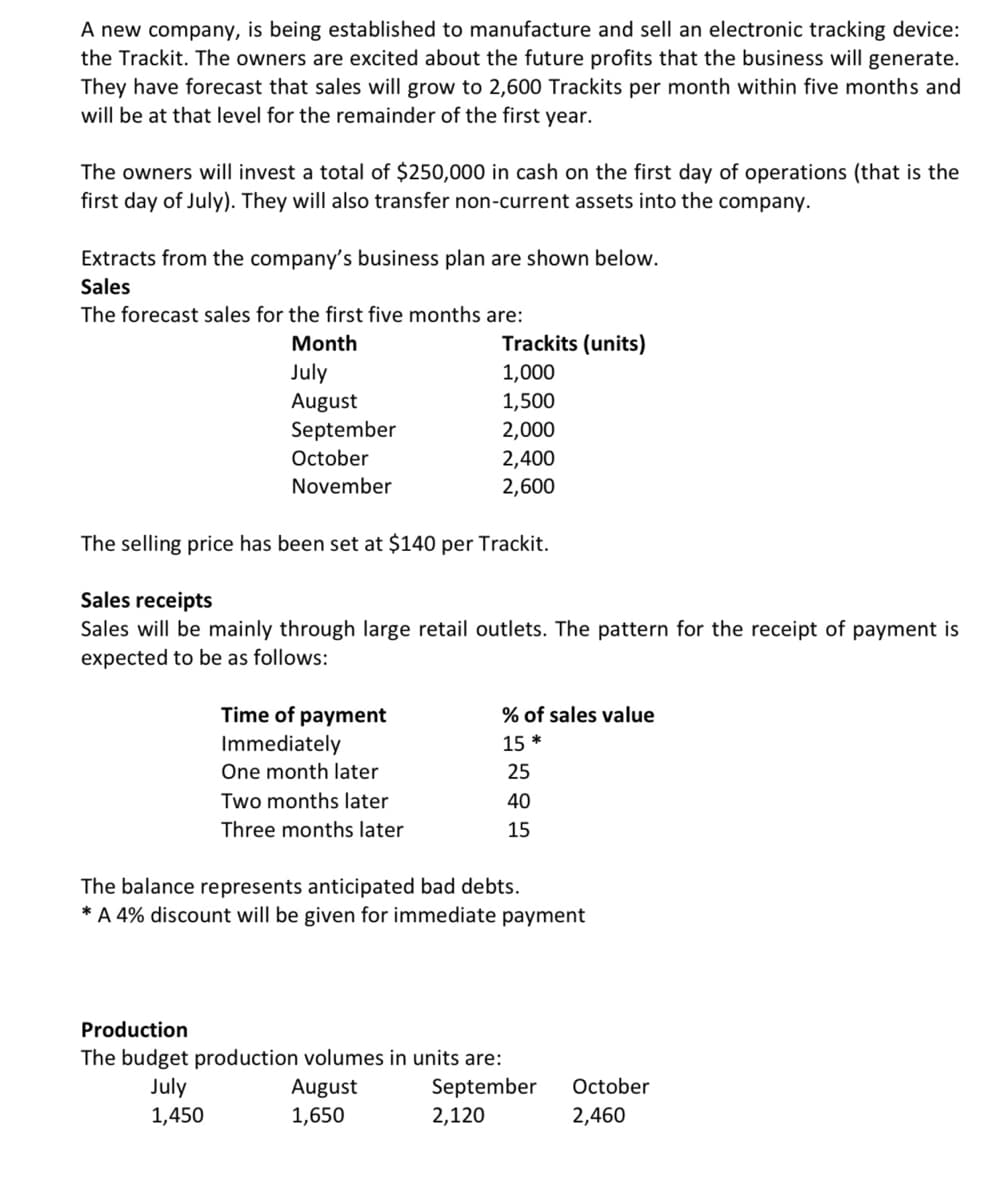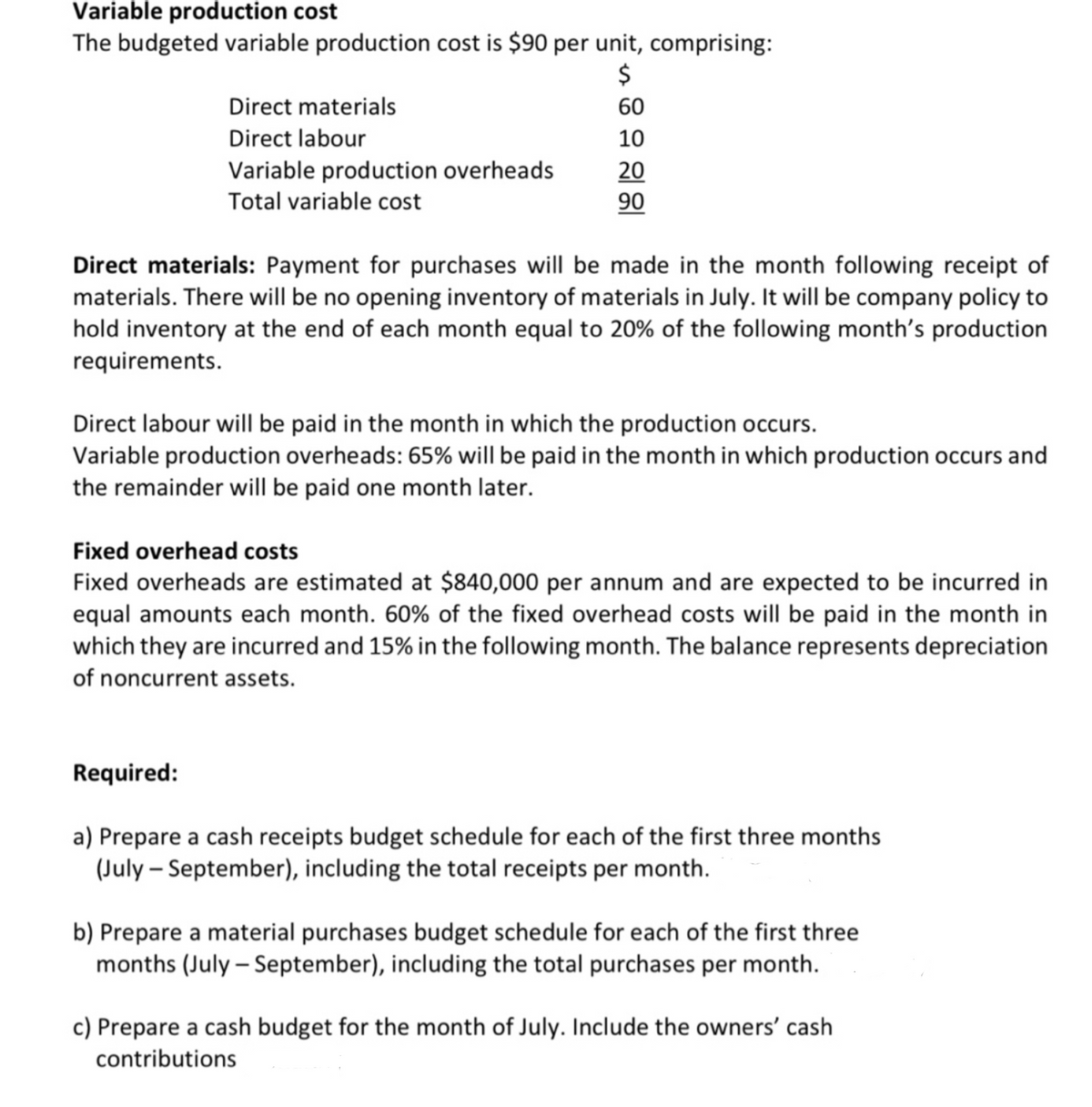A new company, is being established to manufacture and sell an electronic tracking device: the Trackit. The owners are excited about the future profits that the business will generate. They have forecast that sales will grow to 2,600 Trackits per month within five months and will be at that level for the remainder of the first year. The owners will invest a total of $250,000 in cash on the first day of operations (that is the first day of July). They will also transfer non-current assets into the company. Extracts from the company's business plan are shown below. Sales The forecast sales for the first five months are: Month Trackits (units) July August September 1,000 1,500 2,000 October 2,400 November 2,600 The selling price has been set at $140 per Trackit. Sales receipts Sales will be mainly through large retail outlets. The pattern for the receipt of payment is expected to be as follows: Time of payment Immediately % of sales value 15 * One month later 25 Two months later 40 Three months later 15 The balance represents anticipated bad debts. * A 4% discount will be given for immediate payment Production The budget production volumes in units are: September 2,120 July 1,450 August 1,650 October 2,460 Variable production cost The budgeted variable production cost is $90 per unit, comprising: $ Direct materials 60 Direct labour 10 Variable production overheads 20 Total variable cost 90 Direct materials: Payment for purchases will be made in the month following receipt of materials. There will be no opening inventory of materials in July. It will be company policy to hold inventory at the end of each month equal to 20% of the following month's production requirements. Direct labour will be paid in the month in which the production occurs. Variable production overheads: 65% will be paid in the month in which production occurs and the remainder will be paid one month later. Fixed overhead costs Fixed overheads are estimated at $840,000 per annum and are expected to be incurred in equal amounts each month. 60% of the fixed overhead costs will be paid in the month in which they are incurred and 15% in the following month. The balance represents depreciation of noncurrent assets. Required: a) Prepare a cash receipts budget schedule for each of the first three months (July – September), including the total receipts per month. b) Prepare a material purchases budget schedule for each of the first three months (July – September), including the total purchases per month. c) Prepare a cash budget for the month of July. Include the owners' cash contributions
A new company, is being established to manufacture and sell an electronic tracking device: the Trackit. The owners are excited about the future profits that the business will generate. They have forecast that sales will grow to 2,600 Trackits per month within five months and will be at that level for the remainder of the first year. The owners will invest a total of $250,000 in cash on the first day of operations (that is the first day of July). They will also transfer non-current assets into the company. Extracts from the company's business plan are shown below. Sales The forecast sales for the first five months are: Month Trackits (units) July August September 1,000 1,500 2,000 October 2,400 November 2,600 The selling price has been set at $140 per Trackit. Sales receipts Sales will be mainly through large retail outlets. The pattern for the receipt of payment is expected to be as follows: Time of payment Immediately % of sales value 15 * One month later 25 Two months later 40 Three months later 15 The balance represents anticipated bad debts. * A 4% discount will be given for immediate payment Production The budget production volumes in units are: September 2,120 July 1,450 August 1,650 October 2,460 Variable production cost The budgeted variable production cost is $90 per unit, comprising: $ Direct materials 60 Direct labour 10 Variable production overheads 20 Total variable cost 90 Direct materials: Payment for purchases will be made in the month following receipt of materials. There will be no opening inventory of materials in July. It will be company policy to hold inventory at the end of each month equal to 20% of the following month's production requirements. Direct labour will be paid in the month in which the production occurs. Variable production overheads: 65% will be paid in the month in which production occurs and the remainder will be paid one month later. Fixed overhead costs Fixed overheads are estimated at $840,000 per annum and are expected to be incurred in equal amounts each month. 60% of the fixed overhead costs will be paid in the month in which they are incurred and 15% in the following month. The balance represents depreciation of noncurrent assets. Required: a) Prepare a cash receipts budget schedule for each of the first three months (July – September), including the total receipts per month. b) Prepare a material purchases budget schedule for each of the first three months (July – September), including the total purchases per month. c) Prepare a cash budget for the month of July. Include the owners' cash contributions
Chapter10: Capital Budgeting: Decision Criteria And Real Option
Section: Chapter Questions
Problem 19P
Related questions
Question

Transcribed Image Text:A new company, is being established to manufacture and sell an electronic tracking device:
the Trackit. The owners are excited about the future profits that the business will generate.
They have forecast that sales will grow to 2,600 Trackits per month within five months and
will be at that level for the remainder of the first year.
The owners will invest a total of $250,000 in cash on the first day of operations (that is the
first day of July). They will also transfer non-current assets into the company.
Extracts from the company's business plan are shown below.
Sales
The forecast sales for the first five months are:
Month
Trackits (units)
July
August
September
1,000
1,500
2,000
October
2,400
November
2,600
The selling price has been set at $140 per Trackit.
Sales receipts
Sales will be mainly through large retail outlets. The pattern for the receipt of payment is
expected to be as follows:
Time of payment
Immediately
% of sales value
15 *
One month later
25
Two months later
40
Three months later
15
The balance represents anticipated bad debts.
* A 4% discount will be given for immediate payment
Production
The budget production volumes in units are:
September
2,120
July
1,450
August
1,650
October
2,460

Transcribed Image Text:Variable production cost
The budgeted variable production cost is $90 per unit, comprising:
$
Direct materials
60
Direct labour
10
Variable production overheads
20
Total variable cost
90
Direct materials: Payment for purchases will be made in the month following receipt of
materials. There will be no opening inventory of materials in July. It will be company policy to
hold inventory at the end of each month equal to 20% of the following month's production
requirements.
Direct labour will be paid in the month in which the production occurs.
Variable production overheads: 65% will be paid in the month in which production occurs and
the remainder will be paid one month later.
Fixed overhead costs
Fixed overheads are estimated at $840,000 per annum and are expected to be incurred in
equal amounts each month. 60% of the fixed overhead costs will be paid in the month in
which they are incurred and 15% in the following month. The balance represents depreciation
of noncurrent assets.
Required:
a) Prepare a cash receipts budget schedule for each of the first three months
(July – September), including the total receipts per month.
b) Prepare a material purchases budget schedule for each of the first three
months (July – September), including the total purchases per month.
c) Prepare a cash budget for the month of July. Include the owners' cash
contributions
Expert Solution
This question has been solved!
Explore an expertly crafted, step-by-step solution for a thorough understanding of key concepts.
Step by step
Solved in 4 steps

Recommended textbooks for you

EBK CONTEMPORARY FINANCIAL MANAGEMENT
Finance
ISBN:
9781337514835
Author:
MOYER
Publisher:
CENGAGE LEARNING - CONSIGNMENT

Cornerstones of Cost Management (Cornerstones Ser…
Accounting
ISBN:
9781305970663
Author:
Don R. Hansen, Maryanne M. Mowen
Publisher:
Cengage Learning

Intermediate Financial Management (MindTap Course…
Finance
ISBN:
9781337395083
Author:
Eugene F. Brigham, Phillip R. Daves
Publisher:
Cengage Learning

EBK CONTEMPORARY FINANCIAL MANAGEMENT
Finance
ISBN:
9781337514835
Author:
MOYER
Publisher:
CENGAGE LEARNING - CONSIGNMENT

Cornerstones of Cost Management (Cornerstones Ser…
Accounting
ISBN:
9781305970663
Author:
Don R. Hansen, Maryanne M. Mowen
Publisher:
Cengage Learning

Intermediate Financial Management (MindTap Course…
Finance
ISBN:
9781337395083
Author:
Eugene F. Brigham, Phillip R. Daves
Publisher:
Cengage Learning



Managerial Accounting: The Cornerstone of Busines…
Accounting
ISBN:
9781337115773
Author:
Maryanne M. Mowen, Don R. Hansen, Dan L. Heitger
Publisher:
Cengage Learning